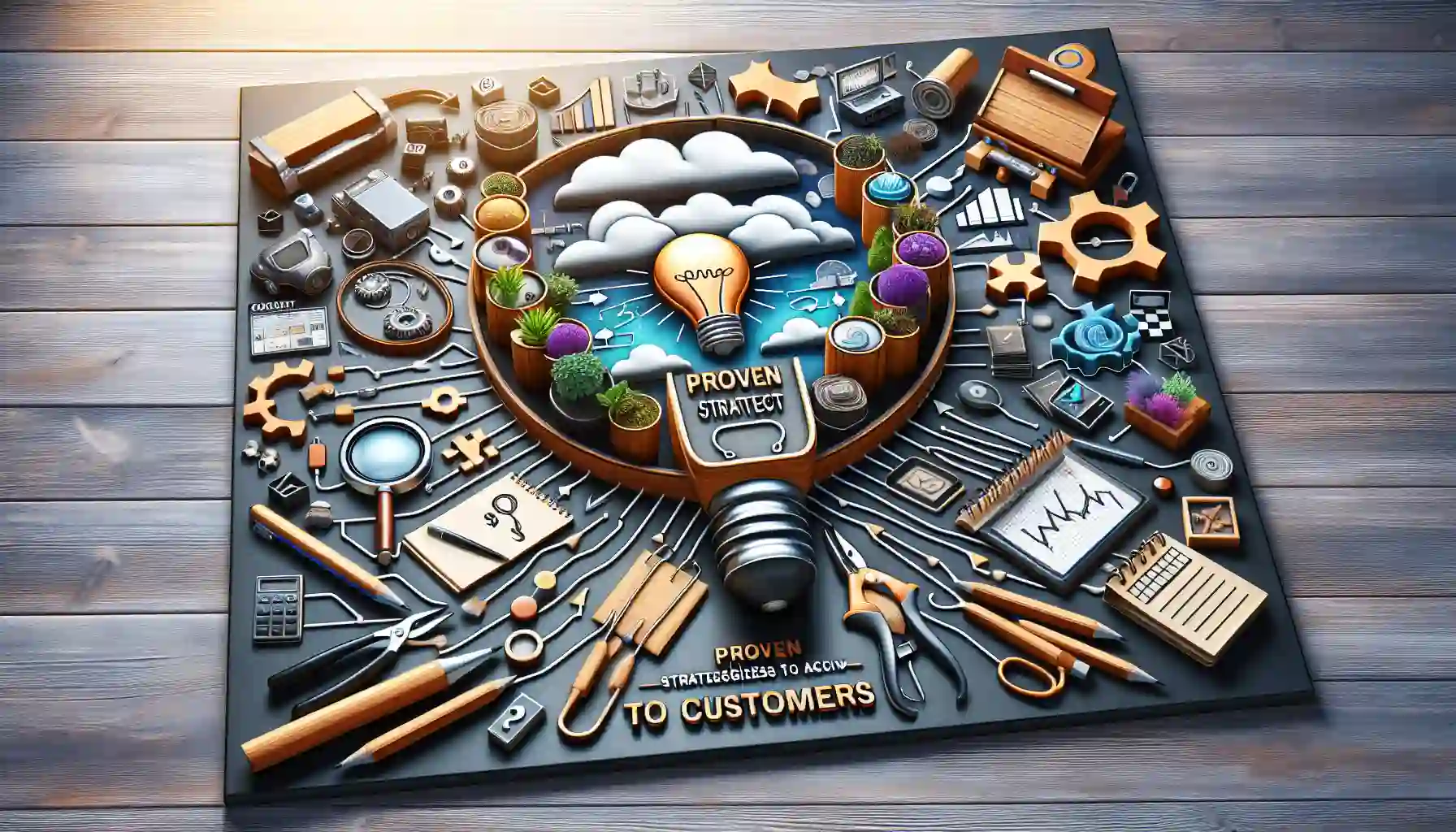
Customer Acquired: Proven Strategies to Acquire Customers

In the crowded marketplace of today, mastering the art of customer acquisition is more important than ever. The ability to effectively acquire customers not only determines the growth trajectory of a business but also its long-term sustainability. As companies strive to connect with potential clients amidst fierce competition, they must adopt diverse strategies that not only draw in leads but also turn them into loyal patrons. This multifaceted approach requires an in-depth understanding of the target audience, the right channels for outreach, and an evaluation of efforts, ensuring that every marketing dollar contributes to growth.
One of the most fundamental components of any successful business strategy involves building a robust and effective customer acquisition plan. The process transcends mere advertising—it's about nurturing potential customers from the first point of contact through to conversion. With the constant evolution of digital marketing and customer engagement methods, businesses must also adapt their tactics. This article delves into proven strategies to acquire customers and evaluates various techniques that companies can implement to thrive in today's competitive environment.
Table of Contents
- Understanding Customer Acquisition: The Key to Business Growth
- The Importance of Customer Acquisition in Today's Market
- Effective Digital Marketing Strategies for Customer Acquisition
- Leveraging Social Media for Enhanced Customer Engagement
- Utilizing Search Engine Optimization (SEO) in Customer Acquisition
- Email Marketing: A Direct Approach to Attract and Convert Customers
- The Role of Traditional Media in Modern Customer Acquisition
- Events and Networking: Building Relationships to Drive Customer Acquisition
- Measuring Success: Key Metrics for Evaluating Customer Acquisition Efforts
- Balancing Cost and Value: Customer Acquisition Cost (CAC) vs. Customer Lifetime Value (CLV)
- Creating an Exceptional Customer Experience to Boost Acquisition
- Integrating Customer Acquisition with Retention Strategies for Sustainable Growth
- Common Pitfalls in Customer Acquisition and How to Avoid Them
- Innovations in Customer Acquisition: Exploring New Channels and Technologies
- Case Studies: Successful Customer Acquisition Strategies from Leading Brands
- Tips and Best Practices for Optimizing Your Customer Acquisition Process
Understanding Customer Acquisition: The Key to Business Growth
At its core, customer acquisition represents the diverse strategies and activities a business utilizes to attract potential customers to its offerings. It’s a vital aspect of business growth that cannot be treated in isolation from the overall marketing strategy. Understanding the intricacies of the acquisition landscape sets the foundation for businesses aiming to expand their customer base effectively.
To successfully acquire customers, businesses need to grasp the customer journey, which consists of several stages: awareness, consideration, and decision. Each stage requires tailored messaging and engagement strategies that resonate with potential customers’ needs. In a world where consumers are inundated with choices, achieving differentiation and making a memorable impact is crucial for standing out amidst the noise.
The Importance of Customer Acquisition in Today's Market
The significance of customer acquisition in today's fast-paced economy cannot be overstated. As competition stiffens across industries, the ability to attract new customers is pivotal for success. A well-executed acquisition strategy not only boosts revenue but also enables businesses to diversify their offerings and expand into emerging markets. It is also instrumental in building brand awareness and elevating a company’s reputation in its sector.
Moreover, a strong focus on acquiring customers helps businesses better understand market demands and consumer behavior. As organizations refine their approach based on data and insights generated from acquisition activities, they become adept at anticipating shifts in the marketplace—ultimately positioning themselves for proactive rather than reactive growth.
Effective Digital Marketing Strategies for Customer Acquisition
Digital marketing plays an indispensable role in customer acquisition, offering businesses a plethora of ways to reach potential clients. The digital landscape is expansive; therefore, companies must integrate various tactics to build an effective acquisition strategy. Key methods include:
- Content Marketing: Creating informative and engaging content can attract potential customers and establish a business as an authority in its niche.
- Pay-Per-Click (PPC) Advertising: Investing in targeted ads allows businesses to reach customers actively searching for related products or services.
- Influencer Marketing: Collaborating with influencers can lend credibility to a brand and enhance its reach among niche audiences.
- Retargeting Campaigns: Following up with visitors who didn’t convert encourages re-engagement and nudges potential customers towards making a purchase.
Creating a Cohesive Digital Strategy
To successfully acquire customers through digital marketing, businesses must create a cohesive strategy that combines various tactics, ensuring they are reaching their target audience effectively. This includes leveraging analytics to measure success and adapt methodologies as necessary. Flexibility is crucial, as evolving trends may demand shifts in focus and resources to maintain competitive advantage.
Social media platforms serve as powerful tools for customer acquisition. With billions of users globally, businesses have unprecedented access to engage with potential customers directly. Effective social media strategies can dramatically enhance brand visibility and foster customer relationships. Strategies to leverage social media for customer acquisition include:
- Building a Brand Community: Create a space where customers can interact with each other and the brand. This engenders loyalty and encourages word-of-mouth referrals.
- Running Targeted Ads: Using social media’s advanced targeting features ensures campaigns reach the most relevant audience.
- Engagement through Content: Sharing authentic, entertaining, or informative content can drive users to take action and engage further with the brand.
- Using Analytics: Analyze social engagement data to refine strategies and understand what resonates with potential customers.
Establishing Authentic Relationships
Ultimately, the success of using social media for acquisition hinges on establishing authentic relationships with followers. Engaging with customers’ posts, responding to queries promptly, and maintaining a consistent brand voice fosters trust, making it more likely that users will convert into paying customers.
Utilizing Search Engine Optimization (SEO) in Customer Acquisition
Search Engine Optimization (SEO) is a critical component of any customer acquisition strategy. By optimizing website content to rank higher in search engine results, businesses increase their visibility to potential customers actively seeking relevant solutions. Key SEO practices include:
- Keyword Research: Identifying and using the right keywords ensures the content aligns with what potential customers are searching for.
- On-Page Optimization: Optimizing content, meta tags, and URLs enhances user experience and boosts search engine rankings.
- Building Quality Backlinks: Earning backlinks from reputable sites enhances credibility and further improves search engine ranking.
- Mobile Optimization: With a growing percentage of users accessing content via mobile devices, ensuring the site is mobile-friendly is crucial.
Measuring SEO Effectiveness
Incorporating SEO into a customer acquisition strategy requires continuous evaluation of performance metrics. Tools like Google Analytics aid businesses in monitoring traffic, bounce rates, and conversion paths—offering insights critical to optimizing SEO efforts.
Email Marketing: A Direct Approach to Attract and Convert Customers
Email marketing remains one of the most effective methods for acquiring customers, delivering personalized messages directly to potential buyers. Whether through newsletters, promotional emails, or automated follow-ups, email offers a unique opportunity to nurture leads. Key strategies for successful email marketing include:
- Building a Targeted Email List: Use sign-up forms on the website, social media pages, and during events to create an engaged email list.
- Personalization: Tailoring communications based on user behavior or preferences significantly increases engagement and conversion rates.
- Compelling Content: Providing valuable content creates a strong incentive for recipients to take action, such as visiting the website or making a purchase.
- A/B Testing: Regularly testing various elements, from subject lines to call-to-action buttons, helps identify what resonates with the audience.
Nurturing Leads to Convert
Email marketing’s effectiveness in customer acquisition is rooted in its ability to nurture leads over time, facilitating conversion through consistent engagement. Rather than treating prospects solely as transactions, building a relationship fosters loyalty and encourages customers to return.
The Role of Traditional Media in Modern Customer Acquisition
Despite the surge of digital channels, traditional media still holds significant value in customer acquisition. Platforms such as television, radio, print, and outdoor advertising continue to reach sizable audiences and can complement digital strategies. Businesses should consider the following:
- Brand Recognition: Traditional media enhances brand awareness and credibility, often providing an effective way to engage with demographics that may not be as active online.
- Integration with Digital Campaigns: Aligning traditional media campaigns with digital efforts helps provide consistent messaging across channels.
- Use of Direct Mail: Sending targeted direct mail to local markets can yield impressive response rates when combined with solid digital strategies.
Evaluating Traditional Media's Effectiveness
Incorporating traditional media into a customer acquisition strategy requires careful evaluation of effectiveness. Businesses can use promotional codes or dedicated landing pages to assess how well particular campaigns perform, measuring their actual contribution to customer growth.
Events and Networking: Building Relationships to Drive Customer Acquisition
Participating in events and networking opportunities creates avenues for direct engagement with potential customers. Showcasing expertise and building relationships in-person fosters trust, ultimately aiding in customer acquisition. Strategies for successful networking include:
- Hosting Workshops or Seminars: Offering value through knowledge sharing can position a business as a leader in its field, attracting interested prospects.
- Attending Industry Conferences: Engaging with potential clients and other businesses at conferences provides opportunities for collaboration and connection.
- Utilizing Trade Shows: Setting up booths at trade shows can facilitate face-to-face interactions with a large number of potential customers.
Follow-Up Post-Event
After engaging with potential customers at events, it’s essential to follow up. Sending thank-you emails or supplemental information can keep the conversation alive and encourage prospects to take further action, ultimately assisting in their acquisition journey.
Measuring Success: Key Metrics for Evaluating Customer Acquisition Efforts
To understand the effectiveness of customer acquisition strategies, businesses must closely monitor various metrics. Insights can guide adjustments, ensuring that resources are utilized efficiently. Key metrics to consider include:
- Customer Acquisition Cost (CAC): This metric calculates the cost of acquiring a new customer by dividing total marketing expenses by the number of new customers in a given period.
- Customer Lifetime Value (CLV): Understanding the total revenue a customer generates during their relationship with a business helps assess whether acquisition costs are justified.
- Conversion Rates: Monitoring how many leads turn into customers across different channels helps identify the most effective strategies.
- Return on Investment (ROI): Evaluating the financial returns of acquisition efforts compared to the costs will guide how much to invest in future strategies.
Iterative Improvement
Ultimately, regularly analyzing these metrics allows businesses to refine their approaches to customer acquisition. Understanding what works and what doesn’t promotes a culture of iterative improvement, fostering long-term success.
Balancing Cost and Value: Customer Acquisition Cost (CAC) vs. Customer Lifetime Value (CLV)
One of the most critical aspects of customer acquisition is understanding the relationship between Customer Acquisition Cost (CAC) and Customer Lifetime Value (CLV). A successful acquisition strategy should deliver CAC that is significantly lower than CLV, ensuring that a business remains profitable. Organizations can maintain this balance by:
- Analyzing Pricing Strategies: Ensuring that products or services are priced appropriately to reflect their perceived value can enhance CLV.
- Segmenting Customers: Recognizing that different customer segments provide varying CLVs allows businesses to tailor acquisition efforts accordingly.
- Investing in Customer Retention: Maintaining existing customers through loyalty programs and excellent service can artificially inflate CLV, subsequently lowering CAC.
Strategic Pricing Decisions
A sophisticated understanding of CAC vs. CLV enables businesses to make informed strategic decisions regarding pricing, marketing budgets, and channel investments. Optimizing these parameters enhances the capability to acquire customers efficiently while driving new growth opportunities.
Creating an Exceptional Customer Experience to Boost Acquisition
To consistently acquire customers, businesses must prioritize delivering exceptional customer experiences. Happy customers are more likely to return and refer others, contributing to organic growth. Strategies to enhance customer experience include:
- Personalization: Tailoring interactions and offerings based on individual preferences significantly enhances customer satisfaction levels.
- Top-Notch Customer Service: Training staff to address inquiries and issues promptly can transform potential negative experiences into opportunities for goodwill.
- Feedback Mechanisms: Actively seeking and incorporating customer feedback provides invaluable insights into areas for improvement and drives innovation.
A Culture of Excellence
By fostering a culture of service excellence and ensuring every touchpoint with a brand leaves a positive impression, companies can significantly enhance their ability to acquire customers. An exceptional customer experience serves as a key differentiator in today’s competitive landscape.
Integrating Customer Acquisition with Retention Strategies for Sustainable Growth
While customer acquisition is the first step in the sales journey, integrating acquisition strategies with retention efforts creates a sustainable growth model. Retaining existing customers is generally more cost-effective than acquiring new ones, making the intersection of these strategies critical. Businesses can achieve this integration by:
- Developing Customer Loyalty Programs: Encouraging repeat purchases and customer loyalty through rewards can effectively reduce churn.
- Regular Engagement: Maintaining communication with customers through newsletters or exclusive offers keeps customers connected and informed.
- Cross-Selling and Upselling: Encouraging existing customers to explore additional products or services maximizes value from the customer relationship.
Holistic Approach to Growth
A comprehensive approach that prioritizes both customer acquisition and retention positions businesses for substantial long-term growth. This balance creates an engaged customer base that not only contributes to ongoing revenue but enhances brand advocacy.
Common Pitfalls in Customer Acquisition and How to Avoid Them
While building a customer acquisition strategy is essential for growth, businesses must be aware of common pitfalls that may hinder success. Recognizing these challenges can mitigate risks and enhance outcomes. Common pitfalls include:
- Neglecting Existing Customers: Focusing solely on new customer acquisition can alienate existing customers. Retention should always be part of the strategy.
- Ignoring Data: Failing to analyze data means missing insights necessary for optimization. Continuous assessment is vital.
- Overextending Budgets: Investing heavily in acquisition campaigns without scrutinizing ROI could lead to unnecessary financial strain.
- Inconsistent Messaging: Sending mixed messages across channels creates confusion and erodes brand trust.
Adopting a Mindset of Learning
A proactive approach to learning from these pitfalls ensures businesses continuously refine their strategies for customer acquisition. Building resilience through adaptation fosters long-term success amidst a dynamic market landscape.
Innovations in Customer Acquisition: Exploring New Channels and Technologies
The landscape of customer acquisition is ever-evolving, with innovations in technology constantly reshaping the way businesses engage with potential clients. Staying updated on new channels and trends is critical for continuous growth. Some notable innovations include:
- Artificial Intelligence (AI): From chatbots to predictive analytics, AI technology enhances customer interactions and streamlines acquisition efforts.
- Voice Search Optimization: With the rise of voice-activated devices, optimizing for voice search becomes essential for visibility.
- Augmented and Virtual Reality: Utilizing immersive experiences provides customers with unique engagement opportunities and product interactions.
- Influencer Marketing Evolution: As social media evolves, influencer partnerships grow to encompass not just personalities but also authentic relationships.
Embracing Change and Adaptability
Innovating within the realm of customer acquisition demands an open mindset towards change. Businesses that embrace new technologies and methodologies position themselves to outpace competitors and meet evolving customer demands.
Case Studies: Successful Customer Acquisition Strategies from Leading Brands

Learning from businesses that have successfully navigated the customer acquisition landscape can provide invaluable insights. Case studies highlight varied strategies that demonstrate how organizations effectively acquire customers. Examples include:
- Airbnb: By leveraging user-generated content and community engagement, Airbnb built a captivating brand narrative, attracting hosts and travelers globally.
- Dropbox: The referral program Dropbox implemented incentivized users to share the platform, resulting in rapid user base growth.
- Slack: Offering a free version of its messaging platform allowed Slack to cultivate a loyal customer base who eventually converted to paid plans.
Learning from Success
Examining these case studies exposes the effectiveness of creative approaches and how they contribute to customer acquisition. Each organization demonstrates that tailored tactics can drive significant growth and brand loyalty.
Tips and Best Practices for Optimizing Your Customer Acquisition Process
To continuously refine the customer acquisition process, businesses should adopt certain best practices. These strategies ensure effective and sustainable growth while enhancing overall engagement:
- Define Clear Goals: Establish specific, measurable goals for acquisition efforts to guide strategy and measure progress.
- Utilize Analytics Tools: Tools such as Google Analytics provide insight into user behavior, enabling effective optimization.
- Prioritize Quality Over Quantity: Attracting the right customers who fit the target audience is more sustainable than pursuing high volumes of irrelevant leads.
- Continuous Testing and Learning: Regularly testing various strategies and adapting based on results ensures a responsive approach to acquisition.
Fostering a Culture of Experimentation
Encouraging experimentation, data analysis, and adaptation across the organization fosters an agile approach to customer acquisition. By remaining receptive to feedback and trends, businesses can thrive in an ever-changing marketplace.
To conclude about - customer acquired
acquire customers
Mastering the art of customer acquisition is an ongoing journey that requires a well-thought-out strategy, adaptability, and a commitment to delivering exceptional experiences. Businesses must integrate various channels—including digital marketing, social media, and traditional media—into a cohesive plan to reach potential customers effectively. By continually measuring success, understanding the delicate balance between CAC and CLV, and prioritizing customer experience, organizations can cultivate sustainable growth in a competitive landscape.
Innovations in technology and evolving consumer behavior necessitate that businesses remain agile in their acquisition strategies. Leveraging case studies and best practices can provide valuable insights into successful tactics, greatly enhancing businesses' ability to acquire customers. Ultimately, a deep commitment to understanding and meeting customer needs will not only boost acquisition efforts but also cultivate long-term loyalty and advocacy, elevating a brand within its market.
If you want to know other articles similar to Customer Acquired: Proven Strategies to Acquire Customers and can visit the categoryMarketing.
Go up






Leave a Reply